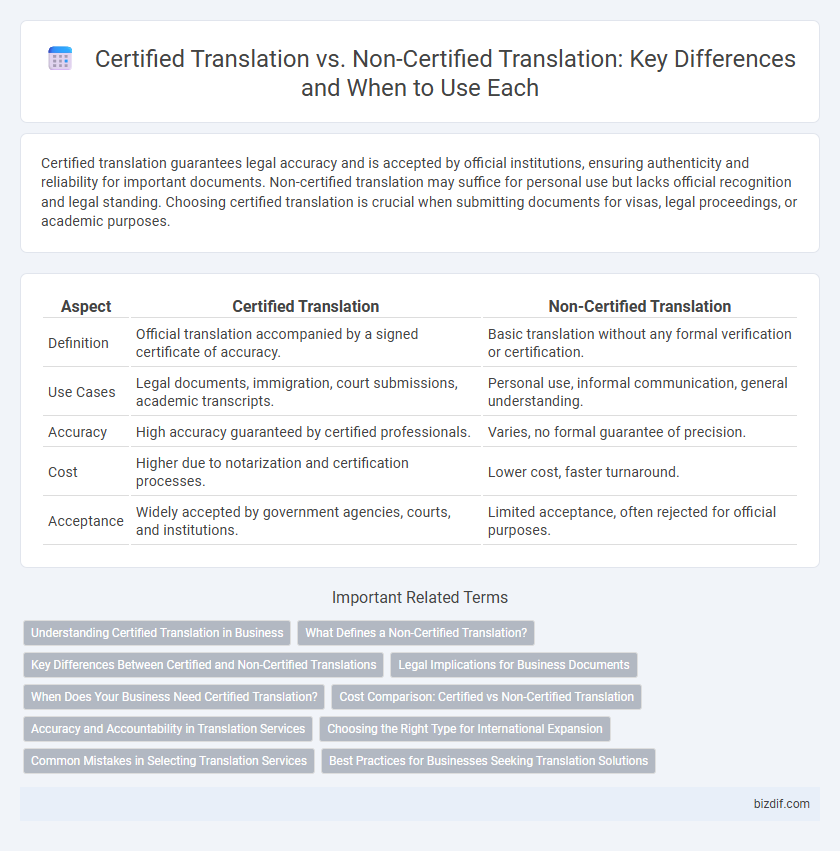Certified translation guarantees legal accuracy and is accepted by official institutions, ensuring authenticity and reliability for important documents. Non-certified translation may suffice for personal use but lacks official recognition and legal standing. Choosing certified translation is crucial when submitting documents for visas, legal proceedings, or academic purposes.
Table of Comparison
| Aspect | Certified Translation | Non-Certified Translation |
|---|---|---|
| Definition | Official translation accompanied by a signed certificate of accuracy. | Basic translation without any formal verification or certification. |
| Use Cases | Legal documents, immigration, court submissions, academic transcripts. | Personal use, informal communication, general understanding. |
| Accuracy | High accuracy guaranteed by certified professionals. | Varies, no formal guarantee of precision. |
| Cost | Higher due to notarization and certification processes. | Lower cost, faster turnaround. |
| Acceptance | Widely accepted by government agencies, courts, and institutions. | Limited acceptance, often rejected for official purposes. |
Understanding Certified Translation in Business
Certified translation in business ensures official documents are accurately translated and legally recognized by authorities, enhancing trust and compliance in international transactions. Unlike non-certified translations, certified versions include a signed statement by a qualified translator verifying authenticity and completeness. This validation is crucial for contracts, patents, and regulatory filings where precise legal language impacts business operations and cross-border agreements.
What Defines a Non-Certified Translation?
Non-certified translation refers to the process of translating documents without official verification or notarization by a certified translator. These translations lack formal acceptance in legal, immigration, or official government proceedings where certified translations are mandatory. Non-certified translations are typically used for personal understanding, informal communication, or internal business purposes where no legal validation is required.
Key Differences Between Certified and Non-Certified Translations
Certified translations are officially recognized documents often required for legal, medical, or immigration purposes, ensuring accuracy and completeness with an accompanying certificate of authenticity. Non-certified translations serve general purposes like understanding foreign texts, lacking formal verification or legal acceptance. Key differences include the presence of certification, intended use cases, and the level of accountability for accuracy.
Legal Implications for Business Documents
Certified translations provide legally recognized accuracy and authenticity, essential for contracts, court documents, and regulatory filings to ensure compliance and avoid disputes. Non-certified translations lack official validation, making them unsuitable for legal submissions and increasing risks of misinterpretation or rejection by authorities. Businesses requiring enforceable documents should prioritize certified translation services to safeguard legal standing and maintain contractual integrity.
When Does Your Business Need Certified Translation?
Businesses require certified translation when legal, regulatory, or official documents must be submitted to government agencies, courts, or international authorities, ensuring accuracy and authenticity. Certified translations are essential for contracts, patents, immigration papers, and financial statements where precise and verifiable language compliance is mandatory. Non-certified translations may suffice for internal communications or marketing materials where formal validation is not required.
Cost Comparison: Certified vs Non-Certified Translation
Certified translations typically cost significantly more than non-certified translations due to the involvement of accredited professionals and notarization processes ensuring legal recognition. Non-certified translations offer a budget-friendly option for informal or internal use but lack the official validation required for legal, immigration, or official documentation. Businesses and individuals should weigh the importance of accuracy and legal acceptance against cost when choosing between certified and non-certified translation services.
Accuracy and Accountability in Translation Services
Certified translation ensures accuracy and accountability through formal verification by authorized translators, guaranteeing that official documents meet legal and institutional standards. Non-certified translation may lack rigorous quality control, increasing the risk of errors and misinterpretations in critical texts. Choosing certified translation protects against liabilities and ensures the faithful representation of original content in legal, medical, or official contexts.
Choosing the Right Type for International Expansion
Certified translation provides official validation required for legal, immigration, and official business documents during international expansion, ensuring accuracy and acceptance by authorities. Non-certified translation suits informal communications, marketing materials, and internal documents where formal approval is not mandatory. Selecting the right type depends on the purpose and destination country's regulatory requirements, balancing cost against the need for authenticity and compliance.
Common Mistakes in Selecting Translation Services
Choosing non-certified translation services often leads to errors in legal, medical, and official documents due to lack of standardized accuracy and authentication. Many clients mistakenly assume cheaper, non-certified translations suffice, risking rejection by institutions and costly delays. Certified translation ensures verifiable accuracy, adherence to industry standards, and acceptance by courts, immigration authorities, and academic institutions.
Best Practices for Businesses Seeking Translation Solutions
Certified translations ensure legal and official document acceptance by governments and institutions due to their accuracy and verified authenticity, making them essential for business contracts, immigration papers, and patent filings. Non-certified translations offer cost-effective and faster alternatives suitable for internal communications, marketing materials, and general content where formal validation is not required. Businesses should assess document purpose and regulatory requirements to decide between certified services for compliance-critical documents and non-certified options for routine translations, optimizing both quality and budget.
Certified Translation vs Non-Certified Translation Infographic

 bizdif.com
bizdif.com